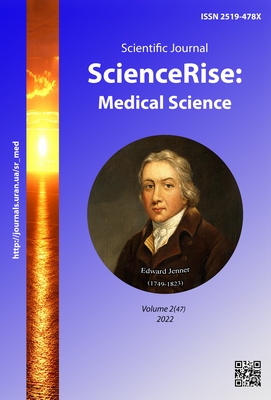Foreign experience of anti-crisis management of medical institutions
DOI:
https://doi.org/10.15587/2519-4798.2022.256383Keywords:
medical institutions, anti-crisis management, crisis situations, healthcare systemAbstract
The main components of the crisis management system of medical institutions were highlighted. Crisis situations will be understood as the inability of medical institutions to provide the population with medical services on time due to lack of various resources.
As a result of catastrophes, natural disasters, armed conflicts, crisis situations arise when medical institutions are not able to fully provide the population with medical services, there is a lack of funding, human and material resources. Ukraine is no exception, as the armed conflict in the East in 2014 and Russia's full-scale invasion of Ukraine confirmed the lack of sufficient labor, logistical resources and financial support to provide quality medical care to the population. In such conditions, there is a need to develop tools, means of overcoming crisis situations in healthcare facilities.
The aim of the article is to systematize the recommendations for Ukraine on the formation of a system of crisis management of healthcare facilities.
Materials and methods of the research. The basis for the study were provided by private clinics for analysis documents of financial and economic reporting for the pre- and post-crisis periods, as well as scientific works of famous Ukrainian and foreign scientists. The research used methods of analysis, comparison, medical and statistical method and system.
The result of the study was an analysis of the state of funding for healthcare facilities in Ukraine and a comparative analysis with the state of funding for such facilities in other developed countries such as Italy, Germany, Sweden, France.
Conclusions. The main components of the system of anti-crisis management of medical institutions in crisis conditions are: effective leadership, which is provided by managers and management staff; human resources; equal access to basic medicines, vaccines and technologies of guaranteed quality, safety, efficiency; a functioning health information system has been established; financing of healthcare institutions and their financial protection in case of crisis; the process of providing quality, safe and efficient medical services with minimal expenditure of resources. In most European countries, the basic functions of healthcare management (prioritization, financing, service delivery, supply planning, quality control) are decentralized and carried out at the level of regional or local authorities, or regional health insurance funds or trusts
References
- Bakai, A. Ye. (2017). Pidhotovka medychnykh kadriv dlia roboty v nadzvychainykh sytuatsiiakh: mizhnarodnyi dosvid. Available at: http://ir.nmapo.edu.ua:8080/jspui/bitstream/lib/4700/1/Тези-макет2017.pdf Last accessed: 07.11.2019
- Vetokha, N. Yu., Sabetska, T. I. (2018). Stratehiia finansuvannia zakladiv okhorony zdorovia: zarubizhnyi dosvid. Ivano-Frankivskyi navchalno-naukovyi instytut menedzhmentu TNEU, 113–117. Available at: http://dspace.tneu.edu.ua/bitstream/316497/33220/1/Сабецька%20Т.І.%2C%20Ветоха%20Н.Ю..pdf Last accessed: 07.11.2019
- Vovk, V. M., Kister, A. (2016). Modeliuvannia stratehii formuvannia vytrat u polskykh likarniakh u konteksti instytutsionalizatsii. Visnyk NUVHP, Seriia «Ekonomichni nauky», 2 (74), 39–56.
- Korol, A. (2019). Analiz dosvidu derzhavnoho upravlinnia nadanniam ekstrenoi medychnoi dopomohy u respublitsi Polshcha ta mozhlyvist yoho vykorystannia v Ukraini. Pressing Problems of Public Administration, 1 (55), 175–182. doi: http://doi.org/10.34213/ap.19.01.23
- Onyshko, S. V., Shevchuk, Yu. V. (2016). Problemy finansuvannia i perspektyvy rozvytku medychnoho strakhuvannia v Ukraini. Intelekt XXI, 5, 158–162.
- Shomnykova, A. V. (2017). Foreign experience of organization and planning of medical services’ market infrastructure. Scientific Papers of the Legislation Institute of the Verkhovna Rada of Ukraine, (5), 95–104. doi: http://doi.org/10.32886/instzak.2017.05.14
- Current health expenditure (CHE) as percentage of gross domestic product (GDP) (%). Available at: http://apps.who.int/gho/data/node.main.GHEDCHEGDPSHA2011?lang=en Last accessed: 07.11.2019
- Current health expenditure (CHE) per capita in PPP. Available at: http://apps.who.int/gho/data/node.main.GHEDCHEpcPPPSHA2011?lang=en Last accessed: 07.11.2019
- Current health expenditure (CHE) per capita in US$. Available at: http://apps.who.int/gho/data/node.main.GHEDCHEpcUSSHA2011?lang=en Last accessed: 07.11.2019
- Domestic private health expenditure (PVT-D) as percentage of current health expenditure (CHE) (%). Available at: http://apps.who.int/gho/data/node.main.GHEDPVTDCHESHA2011?lang=en Last accessed: 07.11.2019
- Medical doctors. Available at: http://apps.who.int/gho/data/node.main.HWFGRP_0020?lang=en Last accessed: 07.11.2019
- Alshrafi, M. A. Y. (2016). Derzhavne antykryzove upravlinnia medychnoiu haluzziu. Ekonomika i upravlinnia medychnoiu haluzziu, 2 (22), 34–43.
- Nursing and midwifery personnel. Available at: http://apps.who.int/gho/data/node.main.HWFGRP_0040?lang=en Last accessed: 07.11.2019
- Out-of-pocket expenditure as percentage of current health expenditure (CHE) (%). Available at: http://apps.who.int/gho/data/node.main.GHEDOOPSCHESHA2011?lang=en Last accessed: 07.11.2019
- Lekhan, V. M., Kriachkova, L. V., Volchek, V. V., Rostochylo, S. S. (2016). Comparative analysis of the approaches to the development of primary health care in European countries and in Ukraine. Ukraina. Zdorovia natsii, 4 (40), 149–161.
- Petrushka, O. V. (2017). Peculiarities of functioning of medical insurance models in economically developed countries. Available at: http://dspace.tneu.edu.ua/bitstream/316497/25375/1/Stattya_Petrushka%202017.pdf Last accessed: 07.11.2019
- Kister, A., Kwit, T. (2013). Organizational changes propositions in hospitals based on diagnosis of medical staff knowledge. Zadar: International Conference MakeLearn.
- Shyrafi, M. A. A. (2016). Formation of the organizational-economic mechanism of crisis management medical industry. Chasopys ekonomichnykh reform, 3 (23), 6–12.
Downloads
Published
How to Cite
Issue
Section
License
Copyright (c) 2022 Katherine Shchyrina, Svitlana Koshova, Oksana Parkhomenko-Kutsevil

This work is licensed under a Creative Commons Attribution 4.0 International License.
Our journal abides by the Creative Commons CC BY copyright rights and permissions for open access journals.
Authors, who are published in this journal, agree to the following conditions:
1. The authors reserve the right to authorship of the work and pass the first publication right of this work to the journal under the terms of a Creative Commons CC BY, which allows others to freely distribute the published research with the obligatory reference to the authors of the original work and the first publication of the work in this journal.
2. The authors have the right to conclude separate supplement agreements that relate to non-exclusive work distribution in the form in which it has been published by the journal (for example, to upload the work to the online storage of the journal or publish it as part of a monograph), provided that the reference to the first publication of the work in this journal is included.









